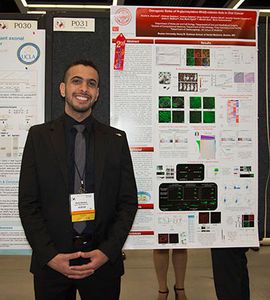Khalid Alamoud Receives Award for Poster Presentation at American Head & Neck Society Conference
By Jason Stevens

Dr. Khalid Alamoud, Ortho 19, DScD 19, at the Henry M. Goldman School of Dental Medicine (GSDM), presented his recent research conducted in the Department of Molecular & Cell Biology at the 9th International Conference on Head and Neck Cancer: Technology Transforming Head and Neck Cancer Care. Dr. Alamoud is a post-doctoral student in the Department of Orthodontics and the Department of Molecular & Cell Biology at Henry M. Goldman School of Dental Medicine (GSDM). This event was held in Seattle, Washington, from July 16 to 20, 2016, and was hosted by the American Head & Neck Society. Dr. Alamoud’s poster, Oncogenic Roles of N-glycosylation-Wnt/ β-catenin Axis in Oral Cancer, was awarded second place in the Cancer Biology category from a total of 68 presentations.
Oncogenic Roles of N-glycosylation-Wnt/Beta-catenin Axis in Oral Cancer is a product of collaborative research by Dr. Alamoud and other GSDM researchers. In addition to Dr. Alamoud, the authors are Khikmet Sadykov, Research Study Technician; Dr. Manish Bais, Research Associate Professor in the Department of Molecular and Cell Biology; and Dr. Maria Kukuruzinska, Associate Dean for Research and Professor in the Department of Molecular & Cell Biology. The research that resulted in this poster was facilitated by funding received by the Etiology and Pathology of Oral Cancer (EPOC) Affinity Research Collaborative from GSMD and the Evans Center for Interdisciplinary Biomedical Research.
Dr. Alamoud’s poster explored the role of N-glycosylation-Wnt/β-catenin in oral squamous cell carcinoma (OSCC). OSCC accounts for the majority of head and neck cancers, but there are currently few therapeutic options available. Previous research by Dr. Kukuruzinska’s team has shown that increased N-glycosylation activates Wnt/β-catenin signaling and tumor spheroid growth in OSCC cells. From this, the research team hypothesized that aberrant activation of N-glycosylation-Wnt/β-catenin axis in oral tissues drives the Cancer Initiating Cells state and promotes OSCC progression to aggressive disease.
Dr. Alamoud used 12-color flow cytometry with cell sorting (FACS) for simultaneous single cell phenotypic characterization and purification of oral CICs from OSCC cell lines and fresh human tumor specimens. The results suggest that N-glycans can serve as powerful detection tools for more aggressive OSCC. Also, N-glycosylation collaborates with β-catenin/CBP signaling to maintain oral CICs.
“Congratulations to Dr. Alamoud on his award at the International Conference on Head and Neck Cancer. I was most impressed by the quality of his research and poster presentations, he is clearly very deserving of this award,” said Dean Jeffrey W. Hutter.
“We are very pleased to have had Khalid represent GSDM at the 9th International Conference on Head and Neck Cancer, and we congratulate him on his award,” said Dr. Kukuruzinska. “Our findings have promising therapeutic implications, and Khalid will be continuing to work on this important research.”